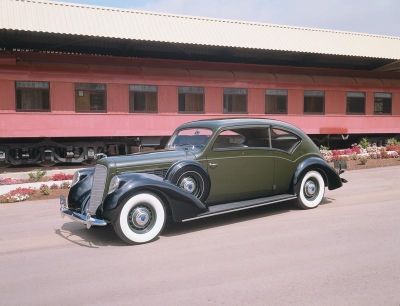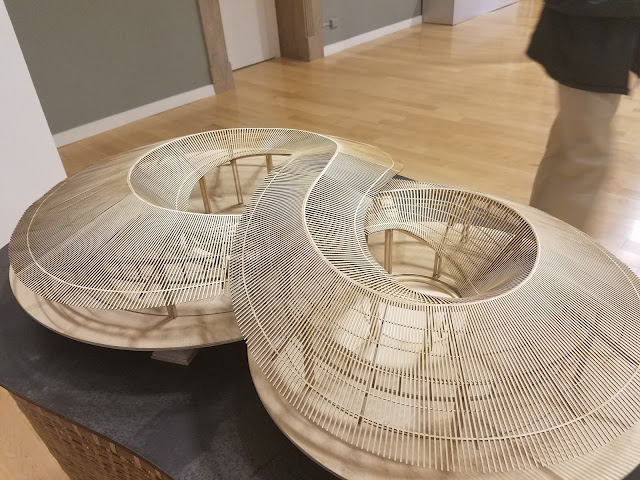The world of etceterini was animated by tuners, enterprising and improvising mechanics that Americans would call hot rodders, as well as some true car manufacturers, albeit at a small scale. In the case of Virgilio Conrero, it's difficult to say where one description fades into another, but it's not so difficult to appreciate his work. Born in Turin in the last year of World War I, Conrero served as an aircraft mechanic during World War II and started Conrero Autotechnica in 1951. He began by tuning Alfa Romeos, and was just in time to capitalize on the launch of the new 1900, Alfa's first mass-produced car. Soon he was putting his own personal stamp on race cars such as this 1953 Conrero Alfa 1900, which marked the first appearance of Ghia's "Supersonic" body style...
The sleek, low-roofed design by Giovanni Savonuzzi referred to the world of aircraft in details like the fins, jet exhaust-shaped tail lights and transparent roof. In the photo above, the car takes off on its ill-fated run in the 1953 Mille Migia, Italy's legendary thousand-mile race on public roads. The car crashed, but not before attracting a lot of attention, which led Ghia to build versions of this body on Fiat 8V, Aston Martin and Jaguar chassis.
It may be appropriate that the Supersonic outfit wound up clothing several different makes of car, because under the skin Conrero's Supersonic was already several makes. The tubular chassis designed by Conrero featured a Fiat 1400 front suspension, while the twin- cam Alfa Romeo 1900 inline four sent power to the rear wheels through a transaxle sourced from a Lancia Aurelia.
During that same year, Conrero produced this Alfa 1900 Sport below, with right-hand drive and bodywork reminiscent of Vignale's Ferrari spiders from the same era. The simple grille design, with concave vertical bars, would appear on some Zagato-bodied Fiat 8V coupes which would compete with Conrero Alfas in the 2 liter class...
Throughout the 1950s more competition spiders appeared; some, like the 1957 example below, featured the traditional Alfa grille shape. The coachwork supplier was not credited, but the body was in alloy on a tubular chassis.
By the time the Sixties arrived, Conrero's racers had made enough of a mark that Standard Triumph approached the Italian firm to design a trio of racing coupes for Le Mans. These were to use the twin-cam Triumph Sabrina inline four which had appeared in the TRS racers at Le Mans in 1959...by accident or design, Conrero seems to have become a specialist in coaxing more performance out of two-liter inline fours. The body design was by Giovanni Michelotti, and it was built in alloy over a tubular chassis with a disc brake at each corner...
Only one example, the purposeful green car above, was completed in 1962 before budget-conscious Triumph management cancelled the program. Tested on the M1 motorway, the 165 hp Conrero Triumph managed nearly 150 mph. It never made the starting grid at Le Mans, but was sent to the States with some other Sabrina-powered racers, and is now being restored in England. The aerodynamic nose would have presented an appealing face if it had been allowed to influence the conservative company's production cars.
The Conrero Alfa Romeo Goccia from 1961, also designed by Giovanni Michelotti, displays a similar concern for slippery passage through the air. Unlike the Conrero Triumph, the Goccia (Italian for teardrop, and pronounced "gotcha") was not part of an official factory racing program. By 1961, Zagato was already bodying Alfa Romeo Giuliettas for racers and rally drivers, and these were offered through Alfa dealers. Conrero had, however, started modifying the alloy block Alfa 1300 engines, offering some with twin-plug heads before Alfa got around to that, with alternative displacements of 1100 or 1500 cc. The Goccia was based on a 1957 Giulietta spider chassis, with 4 speed gearbox, and claimed a top speed of over 130 mph.
By 1965 Conrero had built an Alfa-based Le Mans spider with a Giulietta-based engine with displacement reduced to 1100 cc. It featured sparse, low-drag bodywork in light alloy, and an independent rear suspension with inboard rear brakes, all in a tubular chassis to Virgilio Conrero's design. During this period, Conrero also began to work on Simca and Renault engines.
In 1970, shortly after the appearance of the Opel GT from GM's German division, Conrero began tuning and preparing Opels for competition. As at the beginning, Conrero was again working on coaxing race-winning performance from a 1.9 liter inline four. In the first year, the Conrero Opel GT won its first race in the Italian Touring Car series. Conrero-modified 4 and 6 cylinder Opels continued to find success in European rallying and touring car racing through 1987. Virgilio Conrero died in 1990, but his firm continued its work modifying and tuning Opel race cars until 1997, making it one of the longest-lived of the Italian competition specialists.
Top through 3rd: coachbuild.com
4th: mossmotoring.com
5th: pinterest.com
6th & 7th: mossmotoring.com
8th: classicdriver.com
9th: Phil Ward
10th & 11th: Auto Italiana Magazine
12th: conrero.com (official company site)



















































